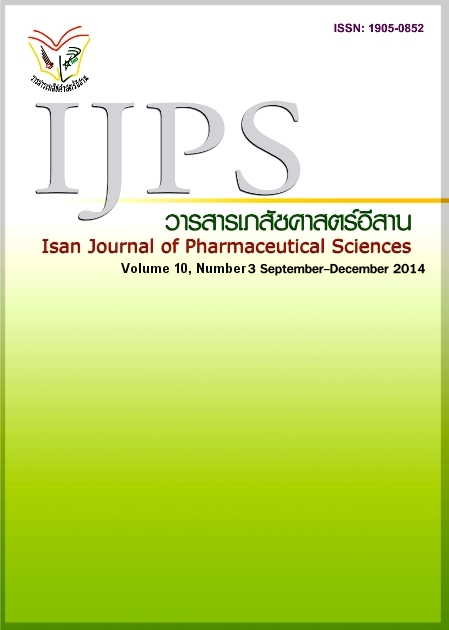Effect of Lactobacillus brevis on Skin Tissue Repair: Antioxidative Effect, Anti-collagenase and Stimulation of Fibroblast Cell Proliferation
Main Article Content
Abstract
Lactobacillus sp, a probiotic bacteria, has long been used for health promotion purposes. This study aimed to investigate factors that affect proliferation phase of skin tissue repair by cell and cellular components of Lactobacillus brevis. Result showed increase significance different antioxidant activityby FRAP and ABTS technique for intact cell and intracellular cell free extract 109cfu/ml. Anti-collagenase activity result showed extracellular extract exhibited the highest anti-collagenase activity at 57.10±14.60%. For stimulation of fibroblast proliferation, intracellular cell free extract demonstrated the tendency to increase fibroblast proliferation as determined by MTT method and extracellular extract showed a significant increase in fibroblast proliferation. This study, therefore, showed antioxidant activity of L. brevis as well as anti-collagenase activity and cell proliferative effect which could be beneficial for the advanced knowledge in the development of skin products from L. brevis to be used for skin care.
Article Details
In the case that some parts are used by others The author must Confirm that obtaining permission to use some of the original authors. And must attach evidence That the permission has been included
References
Armstrong DG, Jude EB. The role of matrix met¬alloproteinases in wound healing. J Am Pediatr Med Assoc 2002; 92(1): 12-18.
Benzie IFF, Strain JJ. The Ferric Reducing Abil¬ity of Plasma (FRAP) as a Measure of Antioxidant Power: The FRAP Assay. Anal Biochem 1996; 239(0292): 70-76.
Biljana E, Boris V, Cena D, Stefkovska DV. Matrix metalloproteinases (with accent to col¬lagenase). J Cell Anim Biol 2011; 5(7): 113-120.
Cadenas E. Mechanisms of oxygen activation and reactive oxygen species detoxification. In: Ahmad S, editor. Oxidative stress and antioxidant defenses in biology. USA: Chapman & Hall: 1995. 1-2.
Fisher GJ, Varani J, Voorhees JJ. Looking older: Fibroblast collapse and Therapeutic Im¬plications. Arch Dermatol 2008; 144(5): 666-672.
Holbrook KA. Structure and Development of the Skin. In: Soter NA, Baden HP, editors. Pathophysiology of dermatologic dis¬ease. 2nd ed. USA: McGraw-Hill; 1991. 1-9.
Kang BS, Seo JG, Lee GS, Kim JH, Kim SY, Han YW, et al. Antimicrobial activity of ente¬rocins from Enterococcus faecalis SL-5 against Propionibacterium acnes, the causative agent in acne Vulgaris, and Its therapeutic effect. J. Microbiol 2009; 47(1):101-109.
Kim HS, Chae HS, Jeong SG, Ham JS, Im SK, Ahn CN et al. In vitro antioxidative prop¬erties of Lactobacilli. Asian-Aust. J. Anim. Sci 2006; 19(2): 262-5.
Li J, Chen J, Kirsner R. Pathophysiology of acute wound healing. Clin Dermatol 2007; 25: 9-18.
Li S, Zhao Y, Zhang L, Zhang X, Huang L, Li D et al. Antioxidant activity of Lactobacillus plantarum strains isolated from tradi¬tional Chinese fermented foods. Food Chem 2012; 135: 1914-1919.
Lin MY, Chang FJ. Antioxidative effect of intesti¬nal bacteria Bifidobacterium longum ATCC 15708 and Lactobacillus acido¬philus ATCC 4356. Dig Dis Sci 2000; 45(1): 1617-22.
Lin MY, Yen CL. Antioxidative ability of lactic acid bacteria. J Agric. Food Chem. 1999; 47: 1460-1466.
Marzio LD, Centi C, Cinque B, Masci S, Giuliani M, Arcieri A, et al. Effect of the lactic acid bacterium Streptococcus thermophilus on stratum corneum ceramide levels and signs and symptoms of atopic dermatitis patients. Exp Dermatol 2003; 12: 615- 620.
Messaoudi DF, Berger CN, Polter MHC, Moal VLL, Servin AL. pH-, Lactic acid-, and non-lactic acid-dependent activities of Probiotic Lactobacilli against Salmonella enteric Serovar Typhimurium. Appl. En¬viron. Microbiol 2005; 71(10): 6008-13.
Niyomploy P, Thunyakitpisal P, Karnchanatat A, Sangvanich P. Antioxidant activity and cell proliferation of crude polysaccharide from rhizome of Curcuma aromatic Salisb. Proceedings of 47th Kasetsart University Annual Conference: Science, 2009 Mar 17-20; Bangkok, Thailand.
Ouwehand AC, Salminen S, Isolauri E. Probiotics: an overview of beneficial effects. Antonie Van Leeuwenhoek 2002; 82: 279-289.
Re R, Pellegrini N, Proteggente A, Pannala A, Yang M, Evans C R. Antioxidant activity applying an improved ABTS radical cation decolorization assay. Free Radic Biol Med 1999; 26: 1231-1237.
Satsue S, Thapphasaraphong S, Damrongrung-ruang T. Antioxidant and collagen stimu¬lating activities in human gingival fibrob¬last cell culture of plant extracts, IJPS 2014 Jan; 9 (Suppl) : 38-43.
Sekhon BS. Matrix metalloproteinases an over¬view. Research and reports in biology 2010; 1: 1-20.
Shalaby EA, Shanab SMM. Antioxidant com¬pounds, assays of determination and mode of action. Afr. J. Pharm. Pharmacol 2013; 7(10): 528-539.
Srisayam M, Weerapreeyakul N, Sribuarin P. In vitro antioxidant activity of white, black and red sesame seeds. IJPS 2014; 10(2): 136-146.
Thring TSA, Hili P, Naughton DP. Anti-colla¬genase, anti-elastase and anti-oxidant activities of extracts from 21 plants. BMC COMPLEM ALTERN M 2009; 9(27): 1-11.
West CE, Hammarstrom ML, Hernell O. Probiot¬ics during weaning reduce the incidence of eczema. Pediatr Allergy Immunol 2009; 20: 430-7.
Zahedi F, Nasrabadi MH, Ebrahimi MT, Shabani M, Aboutalebi H. The effect of lactobacil¬lus brevis isolated from Iranian tradi¬tional cheese on cutaneous wound healing in rats. J Cell Anim Biol 2011; 5(12): 265-70.


